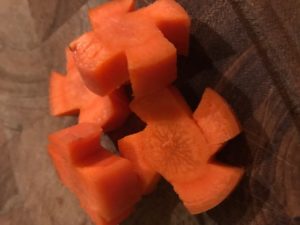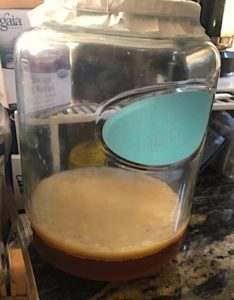I loved teaching at UCSD this past Friday and thanks to all of the resident doctors who attended and Deepa, whose idea it was to have me come. While at the UCSD Class: Fermenting vs. Pickling was discussed at the tail end, it’s the ‘low hanging fruit’ I want to quickly discuss now, in addition to stomach flora, and then in the next couple of days I will go into more detail from the slides and the class. So check back!

I gave a small demo about cutting, and using your knuckles as your guide to prevent cuts. We explored cutting carrots into flowers. And I brought with me my most recent batch of sauerkraut, for all to taste.
I was asked about the difference between Fermenting and Pickling. Wild Fermentation says: Pickling covers much ground beyond fermentation. Pickles are anything preserved by acidity. Most contemporary pickles are not fermented at all; instead they rely upon highly acidic vinegar (a product of fermentation), usually heated in order to sterilize vegetables, preserving them by destroying rather than cultivating microorganisms. “For pickles, fermentation was the primary means of preservation until the 1940s, when direct acidification and pasteurization of cucumber pickles was introduced,” according to Fred Breidt of the USDA. Vinegar sterilized pickles offer the advantage of not being perishable; however, certain nutrients, including vitamin C, are diminished by heat treatment, and vinegar pickles do not contain the live lactic acid bacteria found in raw fermented pickles”.
Here are 2 quick recipes – one for fermenting, one for pickling:
- Cut a thin slice from the ends of each cucumber.
- Meanwhile, combine vinegar, water, and salt in a saucepan and bring to a boil.
- Remove hot jars from canner. Place 1 head fresh dill or 1 tsp (5 mL) dill seeds and 1 clove garlic into each jar; pack in cucumbers.
Preparation for Fermenting Fish from Epicurious:
- 3-4 fresh herring, sardines, mackerel
- white onion
- 1/2 tsp coriander seed
- 10 bay leaves
- 1 tsp black perppercorns
- dill
- 1 Tbsp sea salt
- 3-4 Tbsp whey
For a one-litre jar you need 3-4 fresh herrings or mackerel. Skin the fish and remove the bones, cut into mouth size pieces. Put the pieces of the fish into the jar mixing with peppercorns, a few slices of white onion (optional), coriander seeds, bay leaves and dill seeds or dill herb. In a separate jug in 1/2 litre of water dissolve 1 tablespoon of sea salt and 3-4 tablespoons of whey. Pour this brine into the jar with the fish until the fish is completely covered; if the fish is not covered just add more water. Close the jar tightly and leave to ferment for 3-5 days at a room temperature, then store in the fridge.
With these two recipes, we can easily see that pickling is usually done with vinegar and has no fermentation properties. Pickling is fast and easy and for the purpose of preserving food. Whereas Fermentation, actually does the same, but has “added properties natural bacteria feed on the sugar and starch in the food creating lactic acid. This process preserves the food, and creates beneficial enzymes, b-vitamins, Omega-3 fatty acids, and various strains of probiotics”.
My kids and I make Kombucha from time to time. It’s really easy. Take two bottles of Kombucha, add sugar and leave on the counter. As the Kombucha eats the sugar a ‘scobie’ or mushroom is formed.

We keep it on the counter up to 30 days, not in direct sunlight. The end result is living, healing Kombucha. And it’s way less expensive than $3.75 per bottle. While some people drink a bottle down daily or every other day, my personal preference is half a bottle two days in a row. The only problem you may run into is if you forget there’s a half bottle to finish the next day, it’s dead by the time you get to it.
Hubpages describes the process well: This ‘tea’ is made from the fermentation of a scobie and it is believed to have curative properties, especially in regards to improving the digestive system, boosting the immune system and increasing energy levels. It is also known for helping the skin, promoting well being, and detoxifying. Kombucha has been referred to as a mushroom or Manuchurian mushroom. For centuries it has reputedly been used in Asian and Russian countries. The scobie, also called the mushroom, is not eaten.
I’m sure you want more from a credible source about fermentation and the explanation of its’ value so here’s a quote from a recent Tufts University Newsletter:
GOOD FOR YOUR GUT: It makes sense that fermented foods might improve digestive health. In fermentation, whether for yogurt or beer, bacteria or yeast feed on the natural sugars in foods. These microorganisms create compounds such as lactic acid or alcohol, which help preserve the foods. The fermented foods also wind up filled with “friendly” bacteria such as those touted in probiotic products, as well as helpful enzymes. The bacteria “predigest” certain food components, making them easier for your gut to handle and for nutrients to be absorbed when you eat them. People who are lactose-intolerant usually tolerate yogurt or kefir, because the lactose sugar in these products has been partly broken down by the bacteria in them. Even vegetables can benefit from fermentation: Making cabbage into sauerkraut or kimchi increases glucosinolate compounds believed to fight cancer. Because the gut is the largest component of your immune system, introducing friendly bacteria into your digestive system may also help keep illness away. Evidence suggests that gut health could affect inflammation, allergies and autoimmune disorders in the body as a whole.
Another good topic is about how women sometimes see each other as having ‘willpower’ if they’re not having the cake or sugared food everyone else is eating. But I explained it has to do with Gut Flora and time, rather than willpower.
WebMD talks about Gut Flora this way:
…..in a growing area of scientific research, they’re studying the link between the bacteria in our intestines and virtually every disease that ails us. Bacteria are most likely the most abundant microbes in your intestines, and they’re the focus of most scientific study. Looking at the DNA of the bacteria in stool samples, researchers want to know whether the bacteria cause particular diseases and what we can do to change it.
“There’s a good chance your microbiome is associated with every disease you can think of — diabetes, cancer, autism,” says Michael Snyder, PhD. He’s the director of Stanford University’s Center for Genomics and Personalized Medicine. “And the area where bacteria have a huge impact is your gut.”
If you stop eating sugar, slowly but surely the gut flora calling out to you to eat more sugar will become less and less. That combined with that old rule of ‘it takes 21 days to break a habit’, makes you appear to have more willpower, but you’re actually letting the body and time do the work instead.
So that’s it for Pickling vs Fermentation and Gut Flora. More about the other topics we discussed over the next 4 or 5 days including a video created from the slides.
Happy Healthy Eating,


 Your membership helps feed those in need through No Face Goes Unfed, bringing hope to San Diego and then nationwide.
Your membership helps feed those in need through No Face Goes Unfed, bringing hope to San Diego and then nationwide.
